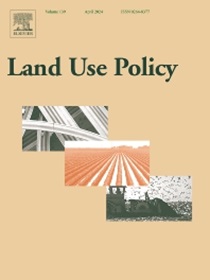迈向可持续土地管理:全面土地退化评估的区域视角
IF 6
1区 社会学
Q1 ENVIRONMENTAL STUDIES
引用次数: 0
摘要
可持续土地管理(SLM)对于缓解土地退化(LD)、恢复退化地区以及确保土地资源的最佳利用以造福今世后代至关重要。LD对农业、水资源和植被产生不利影响,从而损害区域的可持续性。尽管有几种规划工具,但缺乏综合的、多层次的评估,将自上而下和自下而上的方法与包容性的、数据驱动的决策相结合。此外,地理空间数据库在社区一级的潜力在很大程度上仍未得到开发。本研究提出了一个评估LD的方法框架,确定最易受影响的地区,并支持基于证据的土地利用规划。介绍了宏观、中观和微观三层评估,并在印度喀拉拉邦卡萨拉戈德地区尝试了宏观层面的评估。综合评价采用基于主成分分析(PCA)的加权叠加技术,对通过系统文献综述确定的26个关键变量进行加权叠加。通过聚类和热点分析来确定退化的驱动因素和需要立即干预的区域。调查结果显示,按照不同的强度分类,从“非常低”到“非常高”,大约65% %的总面积属于“中等到非常高”的退化类别。此外,36.3% %的退化土地被确定为热点,其中许多与环境敏感区相交。聚类分析将该地区划分为5个不同的区域,显示了退化驱动因素的空间差异,强调需要进一步研究制定因地作则的SLM策略。拟议的方法框架可以适用于类似的情况,所产生的基线数据可以用于未来的发展计划,同时考虑到社会经济和环境影响。该研究为未来在不同背景下的土地发展评估提供了基础,以制定有针对性的土地管理战略。本文章由计算机程序翻译,如有差异,请以英文原文为准。
Towards sustainable land management: A regional perspective for a comprehensive Land Degradation Assessment
Sustainable land management (SLM) is crucial for mitigating land degradation (LD), restoring degraded areas, and ensuring the optimal use of land resources for the benefit of both present and future generations. LD adversely affects agriculture, water resources, and vegetation, thus compromising regional sustainability. Despite the availability of several planning tools, there is a lack of an integrated, multi-level assessment that incorporates both top-down and bottom-up approaches with inclusive, data-driven decision-making. Moreover, the potential of geospatial databases at the community level remains largely unexplored. This study proposes a methodological framework for evaluating LD, identifying areas most susceptible, and supporting evidence-based land use planning. A three-tier assessment at the macro, meso, and micro levels is introduced, and the macro-level assessment is attempted in the district of Kasaragod, Kerala, India. The comprehensive degradation assessment adopted a weighted overlay technique based on principal component analysis (PCA) applied to the 26 critical variables identified through a systematic literature review. Cluster and hotspot analyses were performed to determine the drivers of degradation and areas requiring immediate intervention. Findings reveal that approximately 65 % of the total area falls within the ‘Medium to Very High degradation’ category when classified by varying intensity, ranging from ‘Very low’ to ‘Very high’. Moreover, 36.3 % of the degraded land is identified as hotspots, many of which intersect with environmentally sensitive zones. Cluster analysis divided the region into five distinct zones, which showed the spatial variation in drivers of degradation, highlighting the need for further study to develop context-specific strategies for SLM. The proposed methodological framework can be adapted to similar contexts, and the generated baseline data can be used for future development plans, considering the socioeconomic and environmental impacts. The research provides a foundation for future LD assessments in various contexts to develop targeted land management strategies.
求助全文
通过发布文献求助,成功后即可免费获取论文全文。
去求助
来源期刊

Land Use Policy
ENVIRONMENTAL STUDIES-
CiteScore
13.70
自引率
8.50%
发文量
553
期刊介绍:
Land Use Policy is an international and interdisciplinary journal concerned with the social, economic, political, legal, physical and planning aspects of urban and rural land use.
Land Use Policy examines issues in geography, agriculture, forestry, irrigation, environmental conservation, housing, urban development and transport in both developed and developing countries through major refereed articles and shorter viewpoint pieces.
 求助内容:
求助内容: 应助结果提醒方式:
应助结果提醒方式:


